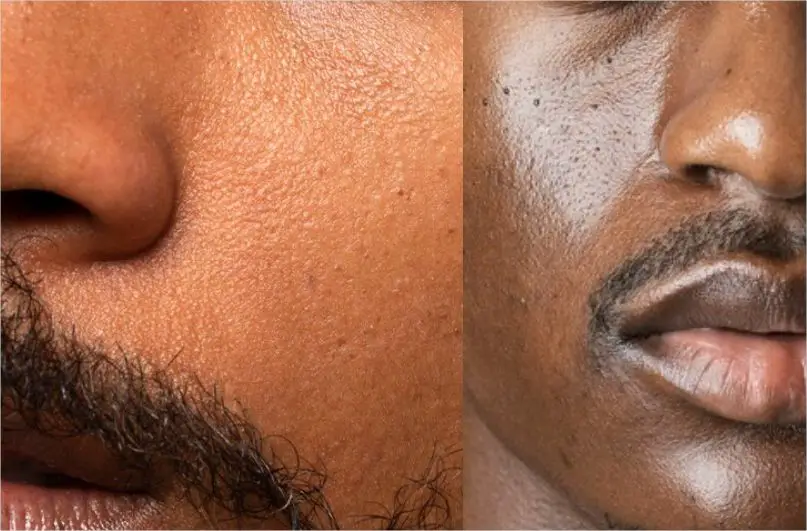Last updated on November 14th, 2025 at 02:16 pm
Men! Here are four ways to identify your skin type and build the perfect skincare routine tailored to your needs.
For men looking to level up their skincare game, performing the skin test and understanding your skin type is the first step to achieving a healthier, clearer complexion.
With so many skincare products available, choosing the right one can feel overwhelming.
However, knowing whether you have oily, dry, combination, or sensitive skin can make all the difference in selecting the right products.
In this guide, we’ll walk you through how to perform the skin test and easily identify your skin type and explain why it’s crucial for building an effective skincare routine tailored specifically for men’s unique needs.
Further Reading: Skincare Products You Should Consider
Table of Contents
- Why Knowing Your Skin Type Matters
- Common Skin Types and Their Characteristics
- 4 Ways to Identify Your Skin Type: Skin Test
- Adjusting Your Skincare Routine Based on Skin Type
- Frequently Asked Questions
- Conclusion
Why Knowing Your Skin Type Matters
Understanding your skin type is the first step in building an effective skincare routine.
Here are reasons why you should know your skin type:
Choosing the Right Products
Knowing your skin type helps you choose the right products, ensuring they cater to your specific needs.
Whether it’s oil-free for oily skin or hydrating for dry skin, using the correct products reduces irritation and boosts skin health.
Targeting Skin Concerns
Knowing your skin type also helps address specific concerns.
If you have combination skin, for example, you might need to treat different areas of your face with different products.
This can help balance oil production and keep your complexion even.
Identifying your skin type allows you to focus on what’s most important, whether it’s controlling acne, reducing redness, or slowing down signs of aging.
Making Smarter Skincare Decisions
When you understand your skin’s needs, you make smarter decisions about the products you use, which leads to better skin health and results.
Tailored skincare routines get you to your desired results faster.
It’s about creating a routine that works for you, not wasting time or energy on products that won’t do the job.
The more you know about your skin type, the more confident you’ll feel about your skincare choices and the outcome.
Common Skin Types and Their Characteristics

Understanding your skin type is key to building an effective skincare routine.
Your skin type impacts how it reacts to products, so knowing it helps you choose what works best for you.
Here are the five main skin types:
Normal Skin
Normal skin is balanced, not too oily, not too dry. It has an even tone and smooth texture with minimal blemishes.
If you have normal skin, a simple skincare routine of moisturizing and protecting your skin from the sun will help maintain its balance.
Oily Skin
If you have oily skin, your skin tends to produce extra oil, leading to a shiny look and enlarged pores.
This can make your skin more prone to breakouts and blackheads.
To manage oily skin, you’ll need products that control excess oil without over-drying.
Dry Skin
Dry skin lacks moisture, which can lead to a tight feeling, flakiness, and dullness. You might also notice fine lines or rough patches.
Rich creams, regular exfoliation, and moisturizing are crucial to help your skin stay hydrated and soft.
Combination Skin
Combination skin shows characteristics of more than one skin type.
You may have an oily T-zone (forehead, nose, chin) while your cheeks are dry or normal.
Treating combination skin means using products that work for both oily and dry areas of your face.
Sensitive Skin
Sensitive skin reacts easily to products and environmental factors. It can become red, itchy, or feel irritated.
To care for sensitive skin, stick to a gentle skincare routine with products designed to soothe and protect without irritating.
Related Posts
Face Care Tips Men Should Master
Anti-aging Skincare Tips for Men
Introduction to Men’s Grooming
Are You Making These Skincare Mistakes?
How You Can Prevent Razor Bumps before they Happen
How to Know the Best Skincare for Your Skin Type
4 Ways to Identify Your Skin Type: Skin Test

Your skin is unique, and knowing your skin type is essential to achieving a clear, healthy complexion.
Identifying your skin type is key to creating a skincare routine that works for you. As corroborated by Nivea, here are simple ways to determine your skin type:
1. Visual Inspection
The first step in a skin test to identify your skin type is to take a close look at your skin’s appearance and texture.
This method is all about using your eyes to observe how your skin behaves throughout the day, especially under natural light. Here’s what to look for:
Oily Skin
Oily skin typically exhibits a shiny appearance, particularly in the T-zone (forehead, nose, and chin).
This shine is caused by an overproduction of sebum, the skin’s natural oil.
Enlarged pores are another common sign of oily skin, which can often become clogged, leading to blackheads or acne.
If your face appears shiny after just a few hours of cleansing, you likely have oily skin.
Dry Skin
Dry skin appears dull, rough, or flaky, especially after cleansing. The skin may feel tight or even sore, particularly after washing.
Dryness can lead to visible flakes or patches, especially around the cheeks and jawline. If your skin often lacks moisture or appears lackluster, it may indicate that you have dry skin.
This type of skin tends to have smaller pores and can sometimes show signs of redness or irritation.
Combination Skin
Combination skin is just as it sounds: it’s a mix of oily and dry skin. The T-zone tends to be oilier, while the cheeks or jawline may feel dry or tight.
You might notice visible pores in your T-zone, but on other areas like the cheeks, your skin may appear more matte or flaky.
This is common, as combination skin can change with the seasons, stress, or other factors.
Sensitive Skin
Sensitive skin is prone to irritation. If your skin frequently reacts with redness, itching, or inflammation after exposure to skincare products, environmental conditions, or even certain foods, you may have sensitive skin.
It’s also common for people with sensitive skin to have conditions like rosacea or eczema, which cause these reactions.
This type of skin can easily become aggravated by harsh chemicals, fragrances, or environmental factors like pollution or extreme temperatures.
Normal Skin
Normal skin is often balanced, without excessive oiliness or dryness.
If your skin looks healthy with a consistent texture, no visible blemishes, and a natural glow, then you most likely have normal skin.
This skin type generally does not show signs of irritation or sensitivity and tends to have smaller pores and fewer visible imperfections.
2. Blotting Paper Skin Test
Another easy and effective skin test to identify your skin type is to use blotting paper.
This test is useful for determining how much oil your skin produces. Here’s how you can do it:
- Step 1: In the morning, before you wash your face, press a piece of blotting paper against different areas of your face (the forehead, nose, chin, and cheeks).
- Step 2: Gently press the paper to absorb any oils from your skin.
- Step 3: Examine the blotting paper for any signs of oil. Based on how much oil is absorbed, you can determine your skin type.
Oily Skin
If you have oily skin, the blotting paper will absorb a significant amount of oil, especially from the T-zone.
Your skin will feel greasy, and the paper will reveal a noticeable greasy residue.
Dry Skin
For dry skin, blotting paper will pick up little to no oil, indicating that your skin isn’t producing much sebum.
Your skin will feel tight or flaky after cleansing, and you may notice dry patches that the blotting paper does not absorb.
Combination Skin
Combination skin will show a different result depending on the area.
The T-zone will produce more oil, leaving a noticeable residue on the blotting paper, while areas like the cheeks may show less oil or none at all.
The blotting paper will help you identify which areas of your face need more attention.
Normal Skin
If your skin is normal, the blotting paper will pick up only a small amount of oil, indicating that your skin produces a balanced amount of sebum.
Your skin won’t feel excessively greasy or dry, and the paper should reveal minimal oil residue.
3. Touch Test
The touch skin test is another simple way to gauge your skin type.
This test involves assessing how your skin feels to the touch and checking for moisture levels.
To perform this test, follow these steps:
- Step 1: Cleanse your face using a gentle cleanser.
- Step 2: Wait for about an hour to let your skin return to its natural state before touching your face.
- Step 3: Touch different areas of your face, including your forehead, nose, cheeks, and chin, using your fingertips. Focus on how your skin feels, whether it’s oily, dry, or balanced.
Oily Skin
If you have oily skin, your face will feel greasy or slick, especially in the T-zone.
It may feel excessively oily after just a short period following cleansing, and your fingers will likely leave a noticeable residue.
Dry Skin
For dry skin, you’ll notice that your face feels tight, rough, or flaky.
Your skin will lack moisture and may even feel uncomfortable or sore.
Dry skin may also have rough patches that can make it feel uneven to the touch.
Combination Skin
Combination skin feels oily in the T-zone but might feel normal or dry in other areas.
Your forehead, nose, and chin will feel slick, while your cheeks may feel dry or even rough in some spots.
Sensitive Skin
Sensitive skin may react negatively to touch, resulting in redness, irritation, or a burning sensation.
While not all sensitive skin reacts to this test, even a light touch can cause discomfort for those with this skin type.
Normal Skin
If your skin is normal, it will feel smooth and balanced.
There will be no greasy or tight sensation, and it will feel comfortable after washing, with a healthy glow and smooth texture.
Normal skin should not feel sensitive or irritated upon touch.
4. Professional Skin Analysis Test
If you’re still unsure about your skin type or want a more detailed analysis, visiting a skincare professional is your next best option for a skin test.
A licensed dermatologist or esthetician can conduct in-depth tests to analyze your skin’s condition under controlled conditions.
These professionals use tools and methods to assess your skin type, taking into account factors like moisture levels, sebum production, and reaction to different skincare products.
A professional skin analysis can provide you with personalized recommendations for products that suit your skin, and they may also offer treatments to help improve your skin’s health.
If you’re experiencing persistent skin concerns, such as acne, rosacea, or dryness that doesn’t respond to home care, seeing a professional can help you address these issues more effectively.
Adjusting Your Skincare Routine Based on Skin Type
Knowing your skin type is the first step in building a skincare routine that works for you.
Men’s skin can be tougher and thicker, so it’s important to use the right products tailored to your skin’s needs.
Whether your skin is oily, dry, combination, sensitive, or normal, there are specific approaches that can help improve your skin’s health.
Men’s Oily Skin
If you have oily skin, the key is to control excess oil without stripping your skin.
Use lightweight, non-comedogenic products like gel-based cleansers that won’t clog your pores.
Oil-free moisturizers will help keep your skin balanced. Ingredients like salicylic acid and niacinamide are great for managing breakouts and shrinking pores.
Exfoliate 2-3 times a week to prevent clogged pores, but don’t overdo it, as that can lead to excess oil production.
Men’s Dry Skin
For men’s dry skin, the focus is on hydration. Look for creamy cleansers that won’t strip away your skin’s natural oils.
Moisturizers with hyaluronic acid or glycerin will help lock in moisture.
Adding a hydrating serum to your routine can boost your skin’s moisture retention.
Avoid exfoliating too much, as harsh scrubbing can worsen dryness and irritation.
Combination Skin
If you have combination skin, you need a balance between managing oily spots and hydrating dry areas.
A gentle foaming cleanser is a good option, followed by a lightweight moisturizer.
You might want to target different areas of your face with different products: use gel creams for oilier areas like your T-zone, and cream-based moisturizers for drier spots like your cheeks.
Sensitive Skin
For sensitive skin, stick with products that are free from fragrances and harsh chemicals.
Use gentle, soothing cleansers with ingredients like aloe vera or chamomile.
Choose moisturizers that help strengthen the skin’s barrier while keeping your skin hydrated. Avoid anything too strong that might irritate your skin.
Men’s Normal Skin
Men’s normal skin is the easiest to care for but still benefits from a balanced routine.
A good moisturizer will keep your skin hydrated, and light exfoliation will maintain smoothness.
You may need to adjust your products depending on the season or any changes in your skin condition.
Frequently Asked Questions
How can I identify my skin type?
You can identify your skin type through visual inspection, blotting paper tests, touch tests, or professional skin analysis.
What is the blotting paper test?
Press blotting paper on your face to see how much oil it absorbs, revealing your skin’s oil production.
How do I care for oily skin?
Use lightweight, oil-free products, gel-based cleansers, and exfoliates to control oil without over-drying your skin.
What is the touch test for skin type?
After cleansing, touch your face to feel if it’s oily, dry, or balanced to identify your skin type.
Conclusion
Knowing your skin type as a man is the first step toward achieving healthier, clearer skin.
By identifying whether you have oily, dry, combination, or sensitive skin, you can make smarter skincare choices that directly target your needs.
This helps you select the right products, avoid irritation, and address specific skin concerns like acne, dryness, or oiliness.
Remember, your skin can change over time due to factors like weather or diet, so re-evaluating your skin type periodically is important.
With this knowledge, you can build a tailored routine for smooth, balanced skin that works with your natural needs.
Pyo Merez is a men’s lifestyle enthusiast and writer about the gentleman’s place and impact on society. Raised by a distinguished gentleman dad, he offers unique insights into how the mind of a gentleman works and how societal norms shape gentlemen’s identity and vice versa.
Through his insightful articles, Pyo taps into the depths of gentleman culture to provide perspectives on etiquette and manners in modern society.

